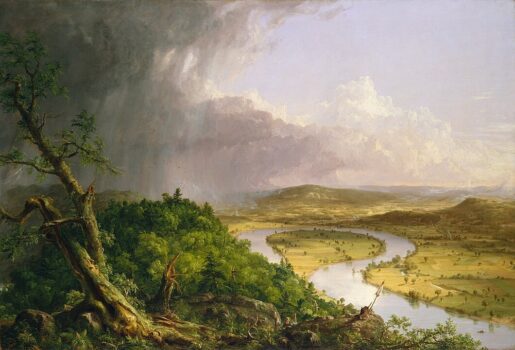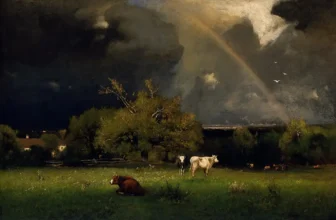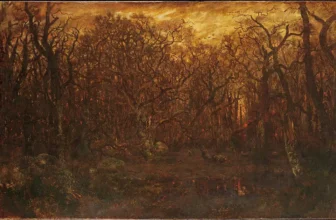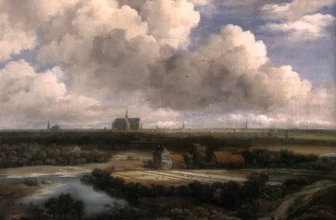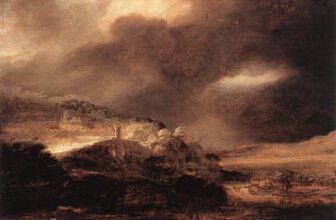The Oxbow Painting by Thomas Cole
In the sweeping landscape of American art history, few works hold the same level of reverence and symbolic weight as “The Oxbow” by Thomas Cole. Officially titled View from Mount Holyoke, Northampton, Massachusetts, after a Thunderstorm (1836), this iconic painting has long been recognized not only for its breathtaking beauty and technical excellence but also for the layered meanings it encapsulates. Painted during a time of profound change in the United States, “The Oxbow” stands as a vivid visual allegory of the American identity, the tension between wilderness and civilization, and the role of the artist in shaping national consciousness.
Who Was Thomas Cole?
To understand “The Oxbow,” we must first understand the man behind the brush. Thomas Cole (1801–1848) was an English-born American artist and the founder of the Hudson River School, a mid-19th-century American art movement embodied by a group of landscape painters whose aesthetic vision was influenced by Romanticism. Cole immigrated from Lancashire, England, to America in 1818. He was largely self-taught but quickly developed a distinct style that blended European Romantic techniques with a uniquely American sense of vastness, spirituality, and the sublime.
Cole viewed the American wilderness as more than just picturesque scenery; for him, it was a sacred space, a living, breathing testament to divine creation. As the United States underwent rapid industrialization and westward expansion, Cole’s work came to reflect a deep concern for nature’s preservation and a critique of human intrusion upon it.
What is The Oxbow Painting?
Painted in 1836, The Oxbow is a large oil on canvas measuring 51.5 x 76 inches. It was created during a pivotal moment in Cole’s career. Commissioned by New York art patron Luman Reed, this painting was part of a larger project and exhibition celebrating American landscapes. In many ways, “The Oxbow” served as Cole’s artistic manifesto.
The painting depicts a panoramic view of the Connecticut River Valley as seen from Mount Holyoke in Massachusetts, following a thunderstorm. This area, often referred to as the “Oxbow” due to the distinctive U-shape bend in the river, is a real location that Cole had visited and sketched.
Today, The Oxbow is housed in the permanent collection of The Metropolitan Museum of Art in New York City, where it continues to attract scholars, art lovers, and tourists alike.
What Is Happening in The Painting?
At first glance, the viewer is confronted with a majestic landscape divided into two contrasting halves:
The Left Side: This side of the canvas is dramatic and tumultuous. It features a dense, untamed wilderness under stormy skies. The trees are wind-blown and wild, the terrain rugged and unyielding. A bolt of lightning can be seen in the distance, and fallen trees suggest the raw power of nature.
The Right Side: In contrast, this portion of the landscape is calm, orderly, and cultivated. The river meanders peacefully through a patchwork of farms and settlements. The clouds are lifting, and sunlight breaks through, illuminating the valley below with a golden hue.
Nestled in the lower-left foreground, nearly hidden among the natural forms, is the tiny figure of Thomas Cole himself, seated at his easel, painting the very landscape that surrounds him. This subtle self-insertion deepens the work’s conceptual resonance, drawing attention to the act of creation and observation.
Symbolism and Meaning in The Oxbow
At its core, The Oxbow is a painting about duality, not only in the visual contrast between wilderness and civilization but also in the philosophical, cultural, and spiritual ideas it reflects.
1. Wilderness vs. Civilization
This is the most immediately apparent contrast. The left side represents the untamed American wilderness, a space of mystery, danger, and divine grandeur. The right side, in contrast, shows domesticated land, structured and shaped by human hands. It reflects the pastoral ideal, Jeffersonian visions of agrarian democracy.
Cole did not depict these oppositions as simple good vs. evil. Rather, he was engaged in a more nuanced dialogue. While he appreciated the progress and productivity that civilization brought, he also lamented the loss of natural beauty and spiritual connection with the land. In this way, the painting becomes a meditation on Manifest Destiny, the 19th-century doctrine that promoted American expansion across the continent. Cole questioned the cost of such progress.
2. Nature as Divine
Cole, like many Romantic artists and thinkers of his time, viewed nature as a direct expression of God. The storm in the left half of the painting can be interpreted as a theophany, a divine presence manifested through natural phenomena. The clearing skies over the cultivated land might suggest divine approval of man’s stewardship, but only if done with reverence. The painting thus subtly warns against environmental hubris.
3. The Role of the Artist
By inserting himself into the scene, Cole emphasizes the artist’s role as interpreter and mediator between nature and society. He stands on the boundary, between storm and sun, wilderness and civilization, poised to capture and make sense of both. This autobiographical touch asserts the moral and spiritual responsibility of the landscape artist, not merely to depict but to guide understanding and values.
4. Sublime and Pastoral
The painting is also a masterclass in the juxtaposition of the sublime and the pastoral, two key aesthetic categories in Romanticism. The sublime, represented by the stormy wilderness, is awe-inspiring and humbling, evoking fear and reverence. The pastoral, seen in the tranquil farmland, is comforting and nostalgic. Cole places these modes side by side, asking the viewer to contemplate the balance between them.
Techniques and Style: What Type of Art Is The Oxbow?
The Oxbow is a quintessential work of the Hudson River School, which can be broadly categorized as American Romantic Landscape Painting. The style is marked by:
Grand scale and panoramic composition
Emphasis on natural detail and light
Idealized yet observational depictions of nature
Integration of allegorical or moral themes
Cole’s technique in The Oxbow reflects his deep understanding of light and atmosphere. The transitions in weather and mood across the canvas are executed with remarkable subtlety. Every tree, cloud, and bend in the river is rendered with both realism and poetic license.
The Hudson River School, through works like The Oxbow, helped forge an American visual identity at a time when the nation was still relatively young and looking for cultural markers to distinguish itself from Europe.
How Did Cole Paint The Oxbow?
Thomas Cole painted The Oxbow in his studio in New York City, but the composition was based on a series of plein air sketches he made during a visit to Mount Holyoke in 1833. These field studies allowed him to capture the specific topography and atmosphere of the region. However, the final painting is not a literal transcription of what he saw but an idealized and composed vision, a synthesis of realism and imagination.
The division of the canvas into two contrasting halves was a deliberate compositional choice. The diagonal line separating storm from serenity serves not only a visual function but a symbolic one as well. Cole used light, perspective, and cloud formations to guide the viewer’s eye across the canvas and emphasize the thematic tension.
His brushwork varies across the canvas, loose and expressive in the wild forest, tight and orderly in the cultivated fields, mirroring the energies of each realm.
Interpretations and Legacy
Over the centuries, The Oxbow has been interpreted in many ways:
Ecological Warning: Some modern scholars view the painting as a prophetic concern over environmental degradation, given Cole’s writings that decried the clear-cutting of forests and industrial pollution.
National Identity: Others see it as a meditation on what it means to be American, balancing rugged individualism with communal harmony.
Political Metaphor: Created during the era of Andrew Jackson, a president Cole disliked, the painting may contain coded critiques of populism and expansionist policies.
Cole’s contemporary audiences would have understood the painting within the context of debates about American development, land use, and the frontier. Today, it continues to resonate in discussions about conservation, sustainability, and the American mythos.
Where Is The Oxbow Painting Today?
The Oxbow resides in The Metropolitan Museum of Art in New York City, within the American Wing. It is part of the museum’s permanent collection and is considered one of its most important American paintings. The work is frequently referenced in textbooks, documentaries, and scholarly essays. It is also a staple of American art history curricula, emblematic of the complex relationship between humanity and the natural world.
The actual location depicted in the painting, the Connecticut River’s oxbow bend near Northampton, Massachusetts, still exists, and it continues to draw tourists, nature lovers, and artists. Mount Holyoke remains a scenic lookout point, and interpretive plaques at the site link the real landscape with Cole’s painted vision.
Why The Oxbow Still Matters
Nearly two centuries after its creation, The Oxbow by Thomas Cole remains a compelling visual essay on the American experience. Through his mastery of form and symbolism, Cole transcended mere landscape painting to engage with deep cultural, spiritual, and ecological questions. He saw the wilderness not as a blank slate for progress but as a sacred trust, one that needed thoughtful stewardship.
In a modern era grappling with climate change, deforestation, and the redefinition of progress, Cole’s vision is more relevant than ever. The Oxbow invites us not only to behold nature but to reflect on our place within it. It is both a celebration and a caution, a prayer and a protest, a timeless dialogue between the land and the people who walk upon it.
